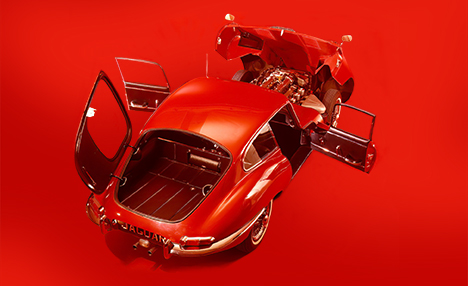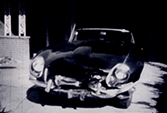From Moss Motoring 1984
By Dave Ramstad
Just three dozen short of 72,000 Big Healeys rolled out of the BMC works at Longbridge, and later Abingdon, between 1952 and 1968. Donald Healey’s “Hundred” hit the United States like a bombshell. Its fresh, sensational lines, ample power, and very attractive price created overnight queues of eager buyers everywhere. Thanks to the postwar automotive revolution begun in The Colonies by MG’s TC and Jaguar’s XK-120, Americans by 1954 were buying British sports cars as if there was no tomorrow. Merchant Marine convoys which a decade earlier crossed the Atlantic eastbound laden with war materiel, now sailed the opposite direction to disgorge thousands upon thousands of Jaguar, MG, Triumph and Austin-Healey sports cars (The Big Four, although there were others) on U.S. piers.
According to modern British Leyand sources, 80% of Big Healey production was destined for the unprecedentedly voracious North American market. In round terms, this translates to nearly 12,000 Hundreds, another 12,000 100-Six types, and a further 34,000 3-liter cars which found ready and willing purchasers in the States. Almost 58,000 Big Healeys were distributed throughout this continent before production ceased in December 1967.
Enthusiasts of the marque Austin-Healey visiting the U.S. from other lands make many observations, chief among them being these two questions: Where are all the clubs? …. and, Where are all those Healeys? It is apparently assumed that the influx of nearly 60,000 Big Healeys during the two decades previous created an extensive, highly organized national network of owners’ clubs throughout the land, and supplied sufficient cars for Big Healeys to be seen on American streets and highways for all time.
 In actuality, the great horde of Healeys sold in the United States worked in some ways to effectively defuse any great national movement. And the marque Austin-Healey was not the sole victim of this irony-the British Sport Car Boom of the 1950’s and 1960’s poured so many cute and sexy two-seaters into the affluent American scene that any vestige of uniqueness or exclusivity was quickly lost. Well-to-do high school and college students drove them to classes, upper-middle-class housewives drove them to the supermarket, and hedonistic, upwardly-mobile young singles and couples drove them everywhere. E-types, TR3’s and 4’s, MGA’s and B’s and Healey 100’s and 3000’s were seen on American streets, highways, and parking lots to such an extent that they simply melted into the panorama of the times. A great many British sports car owners were merely interested in the way the car made them feel, or the image it helped them to project. The truth is, the British sports car became a uniquely American phenomenon, much as the infamous (my adjective) Volkswagen Beetle reigned supreme in the U.S. econo-car field.
In actuality, the great horde of Healeys sold in the United States worked in some ways to effectively defuse any great national movement. And the marque Austin-Healey was not the sole victim of this irony-the British Sport Car Boom of the 1950’s and 1960’s poured so many cute and sexy two-seaters into the affluent American scene that any vestige of uniqueness or exclusivity was quickly lost. Well-to-do high school and college students drove them to classes, upper-middle-class housewives drove them to the supermarket, and hedonistic, upwardly-mobile young singles and couples drove them everywhere. E-types, TR3’s and 4’s, MGA’s and B’s and Healey 100’s and 3000’s were seen on American streets, highways, and parking lots to such an extent that they simply melted into the panorama of the times. A great many British sports car owners were merely interested in the way the car made them feel, or the image it helped them to project. The truth is, the British sports car became a uniquely American phenomenon, much as the infamous (my adjective) Volkswagen Beetle reigned supreme in the U.S. econo-car field.
The opposite side of the coin, of course, is that while four-fifths of Big Healey production was shipped to the States, the balance -something over 14,000 cars- had to somehow satisfy the sports car hunger of the entire rest of the world. The numbers tell the story: A mere three thousand ‘100s’ the same number of 100-6, and only eighty-six hundred 3-liters were spread mighty thin out there. These Healeys led charmed lives, they never had a chance given their relative scarcity to become commonplace, and each and every one was special from the beginning. This is an exaggeration to be sure, but few will doubt that Big Healeys which found themselves in Spain, New Zealand, Germany, Sweden, South Africa, or Australia received a radically different reception and life than those coming to California or New York.
Now, there have always been bands of serious American enthusiasts gathering to enjoy their chosen marque, but their numbers, at least in the case of the Big Healey, continue modest even into these 1980’s. It is estimated that the total combined membership of all Big Healey owners’ clubs on the North American continent does not today exceed 2.500 souls – a respectable figure, but certainly a far cry from those 58,-000 lusty machines which crossed the Atlantic not so long ago. America’s exploding old car hobby, ever-dwindling numbers of Big Healeys, and the steady passage of time automatically guarantee the upward climb of enthusiasm for this marque. The Austin Healey Club’s thirteen year old, San Francisco-based Pacific Centre is currently experiencing rapid growth in regional group activities, while the more senior Austin Healey Club of America, headquartered in Chicago, offers Midwestern owners all the benefits of affiliation. These two major bodies are nicely complemented by a number of highly organized local clubs in various metropolitan areas.
 So, while those original 58,000 imports do not today guarantee a Healey on every street corner or an owners’ club in every hamlet across the country, an individual can with just a little effort discover American Big Healey enthusiasts to rival any in the world. Oh, and where are all those thousands of 100’s. 100-6’s, and 3000’s? Well, a relatively small number of them are seen in ordinary daily service. Just as anywhere else, as they become older, fewer in number, and higher in monetary worth, they are obviously more highly cherished and preserved. Sixteen years after the demise of production, one finds these American Big Healeys more and more typically reserved for club activities, vintage racing, and other pleasurable pursuits. Is not that as it should be?
So, while those original 58,000 imports do not today guarantee a Healey on every street corner or an owners’ club in every hamlet across the country, an individual can with just a little effort discover American Big Healey enthusiasts to rival any in the world. Oh, and where are all those thousands of 100’s. 100-6’s, and 3000’s? Well, a relatively small number of them are seen in ordinary daily service. Just as anywhere else, as they become older, fewer in number, and higher in monetary worth, they are obviously more highly cherished and preserved. Sixteen years after the demise of production, one finds these American Big Healeys more and more typically reserved for club activities, vintage racing, and other pleasurable pursuits. Is not that as it should be?







'Marque Spotlight: Austin Healey-An American View' has no comments
Be the first to comment this post!